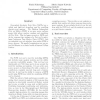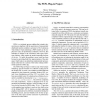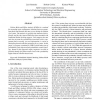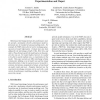99
Voted
QEST
2007
IEEE
15 years 6 months ago
2007
IEEE
Dataflow models are often used for analysing streaming applications. The recently introduced scenario-aware extension of the synchronous dataflow model can capture the dynamism ...
109
click to vote
QEST
2007
IEEE
15 years 6 months ago
2007
IEEE
— Probabilistic models are widely used to analyze embedded, networked, and more recently biological systems. Existing numerical analysis techniques are limited to finitestate mo...
129
click to vote
QEST
2007
IEEE
15 years 6 months ago
2007
IEEE
Generalized Stochastic Petri Nets (GSPNs) are a widely used high-level formalism used for modelling discrete-event systems. The Platform Independent Petri net Editor (PIPE) is an ...
110
click to vote
QEST
2007
IEEE
15 years 6 months ago
2007
IEEE
We investigate logics and equivalence relations that capture the qualitative behavior of Markov Decision Processes (MDPs). We present Qualitative Randomized Ctl (Qrctl): formulas o...
94
Voted
QEST
2007
IEEE
15 years 6 months ago
2007
IEEE
We present a GUI-based tool supporting the stochastic process algebra PEPA with modules for performance evaluation through Markovian steady-state analysis, fluid flow analysis, ...
99
Voted
QEST
2007
IEEE
15 years 6 months ago
2007
IEEE
Failure Mode and Effect Analysis (FMEA) is a method for assessing cause-consequence relations between component faults and hazards that may occur during the lifetime of a system. ...
115
Voted
QEST
2007
IEEE
15 years 6 months ago
2007
IEEE
Among the many stages of a simulation study, debugging a simulation model is the one that is hardly reported on but that may consume a considerable amount of time and effort. In t...
68
Voted
QEST
2007
IEEE
15 years 6 months ago
2007
IEEE
—MOQA is a language specifically designed to facilitate average-case execution time analysis. It incorporates some innovative techniques to make this possible. Following on from...
QEST
2007
IEEE
15 years 6 months ago
2007
IEEE
—Performance Trees are a recently-proposed mechanism for the specification of performance properties and measures. They represent an attractive alternative to stochastic logics,...
QEST
2007
IEEE
15 years 6 months ago
2007
IEEE
XML-based interchange formats for performance models provide a mechanism whereby performance model information may be transferred among modeling tools. For example, the PMIF allow...




